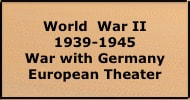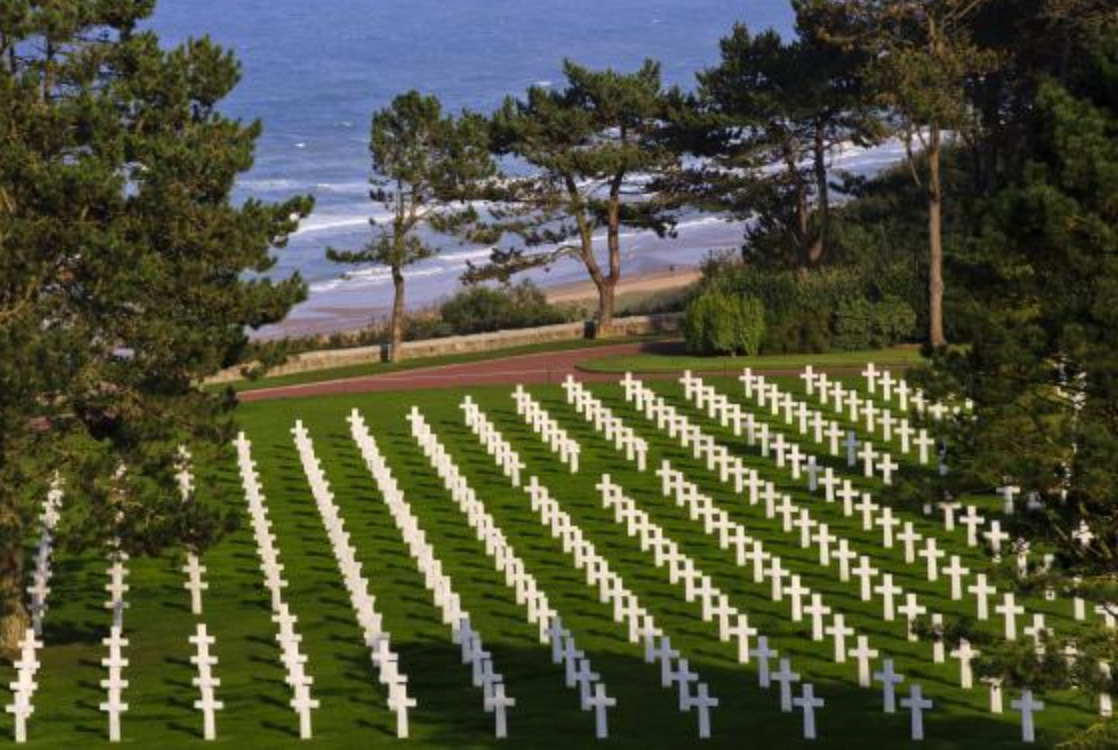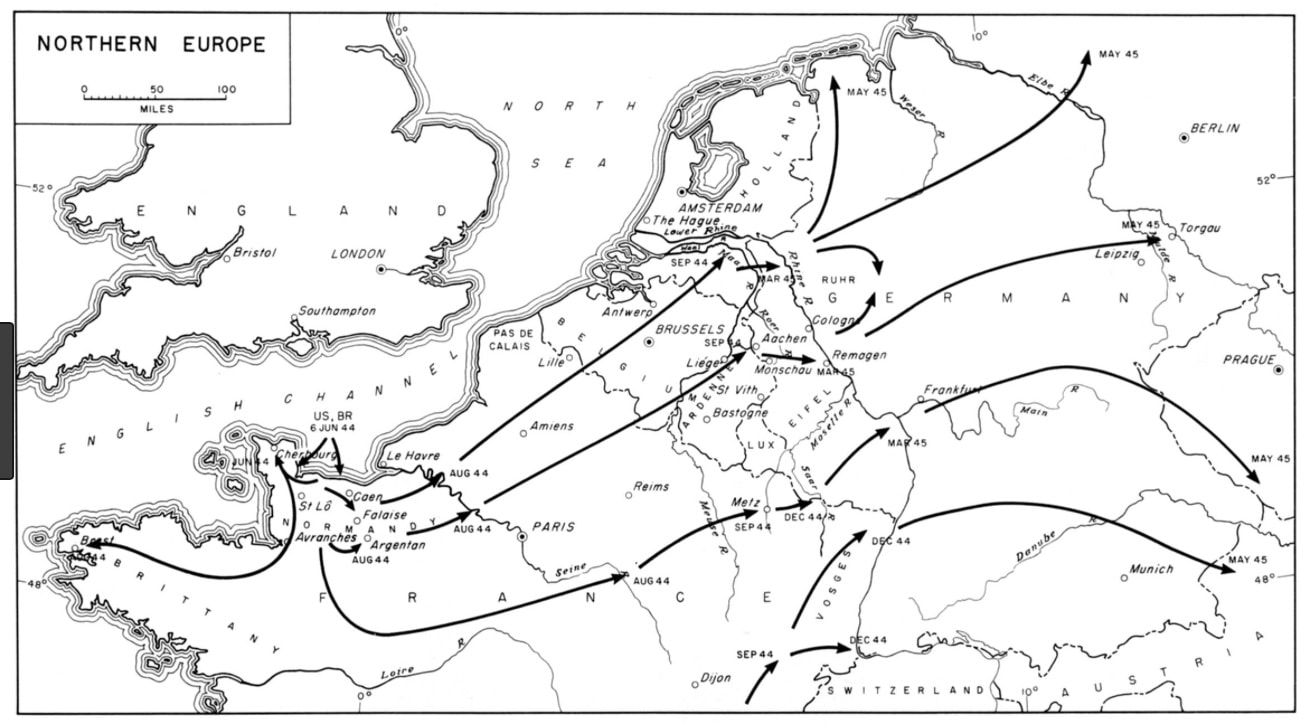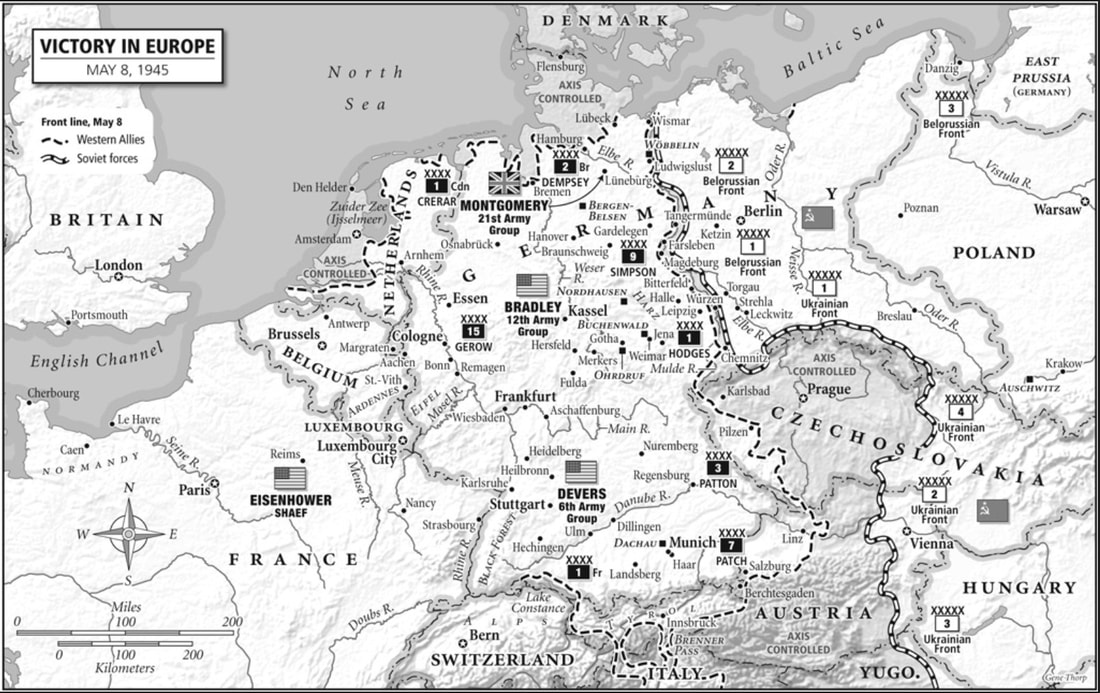bigpigeon.us webpage WWII Germany > The ETO, © 2023 by Robert A. Christiansen, updated by RAC 30 Dec 2023.
Ground combat in the European Theater of Operations (the ETO) began in Normandy, France on D-Day, 6 June 1944, and ended in Germany on 8 May 1945.
Ground combat in the European Theater of Operations (the ETO) began in Normandy, France on D-Day, 6 June 1944, and ended in Germany on 8 May 1945.
Links to Big Pigeon's WWII Germany > The ETO webareas:
Preliminary ETO webpages provide contextual material: Deadly fighting in Normandy through mid-August was followed by the quick liberation of most of France and Belgium:
Preliminary ETO webpages provide contextual material: Deadly fighting in Normandy through mid-August was followed by the quick liberation of most of France and Belgium:
- 1 - The Normandy Campaign, June–July 1944
- 2&3 - Liberation, July–September 1944
- 5 - The War of Attrition, Fall 1944
- The Netherlands, Fall 1944
- The German Rhineland, Fall 1944
- Lorraine and Alsace in northeastern France, Fall 1944
- 4 - Ardennes/The Bulge, December 1944–January 1945
- 4 & 5 - Alsace-Lorraine, 1945, January–February 1945
- 5 - The Siegfried Line, 1945, January–February 1945
- 5 - The Advance to the Rhine, 1945, January–March 1945
- 6 - The Central Europe Campaign, March–May 1945
- Numbers before major webpages correspond with the following official list of ETO campaigns.
- WWII Home contains a list of all subpages.
- Some webpages are still incomplete.
United States Army official list of ETO campaigns with official dates:
- Normandy Campaign, 6 June – 24 July 1944 -- Allies land by sea and air and subsequently expand beachhead.
- Northern France Campaign, 25 July – 14 September 1944 -- German lines are broken; Germany withdraws from most of France and Belgium.
- Southern France Campaign, 5 August – 14 September 1944 -- Germans withdraw from Southern France.
- Ardennes-Alsace Campaign, 16 December 1944 – 25 January 1945 -- German counteroffensives are driven back in the Ardennes and contained in Alsace.
- Rhineland Campaign, 15 September 1944 – 21 March 1945 -- Allies advance to Rhine River.
- Central Europe Campaign 22 March – 11 (sic) May 1945 -- Allies cross Rhine and advance into Germany; war in Europe ends with Germany's surrender effective 8 May.
European Theater Executive Summary, June 1944 - May 1945
Beginning with D-Day, ground combat in the ETO raged over northern and eastern France, Belgium, The Netherlands, Luxembourg, and western Germany.
|
European Theater operations consisted of two periods of grinding combat, each followed by a breakout:
|
The Allied Armies on D-Day, 6 June 1944
The initial Allied forces that landed in Normandy were elements of two armies, comprising the 21 Army Group, under the command of British General Bernard Montgomery.
- The US First Army commanded by General Omar Bradley.
- The British Second Army, with a large Canadian contingent, commanded by General Miles Dempsey.
The Allied Armies on VE-Day, 8 May 1945
|
This map locates the seven front-line armies of the Western Allies at the end of hostilities on Victory in Europe day. Counterclockwise from upper-middle:
British 21st Army Group (Montgomery)
|
Sources for Big Pigeon's WWII Germany > The ETO webpage:
Major Sources:
Major Sources:
- None at this time.
- Normandy American Cemetery, webpage header photo - C/O the American Battle Monuments Commission.
- European Theater Overview, map - C/O the Perry-Castañeda Library Map Collection at the University of Texas in Austin, TX.
- The Victory in Europe map appeared in the the third and final volume of Rick Aktinson's trilogy about United States land operations in the German War.
- https://history.army.mil/html/reference/campaigns.html lists the US Army campaigns in WWII.
- The United States Army official list of ETO campaigns data, https://en.wikipedia.org/wiki/List_of_United_States_Army_campaigns_during_World_War_II.




